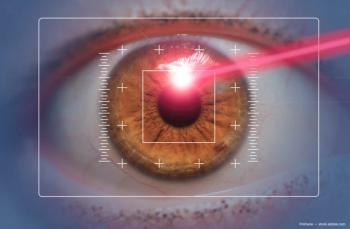
- Ophthalmology Times: September/October 2025
- Volume 50
- Issue 5
Anti-VEGF innovations in retinal disease: From molecules to medicine
Key Takeaways
- Second-generation anti-VEGF agents, like aflibercept 8 mg and faricimab, show improved efficacy and treatment durability in DME and AMD.
- Aflibercept 8 mg provides better anatomic responses and extended treatment intervals due to its slower clearance rate and higher molar dose.
Emerging anti-VEGF agents offer enhanced durability and anatomic outcomes in retinal disease.
The structural differences among newer second-generation anti-VEGF agents—and their implications for clinical efficacy and treatment durability—were the focus of a recent Ophthalmology Times Case-Based Roundtable®. The discussion also highlighted real-world experiences and evidence regarding extended treatment intervals and sustained disease control with these newer therapies.
Michael W. Stewart, MD, summarized the key takeaways from the discussion. He is a professor and the chairman emeritus of ophthalmology at Mayo Clinic in Jacksonville, Florida, and the Knights Templar Eye Foundation Inc. Professor in Ophthalmology Research.
Diabetic macular edema case
Stewart described an 83-year-old woman with diabetic macular edema (DME). She had undergone temporal grid laser photocoagulation for macular edema and received bevacizumab (Avastin; Genentech, Inc) intravitreal injections every 4 to 6 weeks. Recently, aflibercept 2 mg (Eylea; Regeneron Pharmaceuticals, Inc) was administered to treat the worsening edema and visual acuity (VA) in her left eye, in which visual fluctuations between 20/25 and 20/50 occurred. Over 3.5 years, with injections administered every 4 to 6 weeks, the VA decreased with increasing macular edema. Because of the visual deterioration, Stewart switched the patient to faricimab (Vabysmo; Genentech, Inc) with the hope of improving the VA and anatomic response.
With the first injection, the vision was 20/50, but by the third monthly injection, the VA was 20/70. At that time, aflibercept 8 mg (Eylea HD; Regeneron Pharmaceuticals, Inc) became available, and the patient was transitioned to that treatment regimen. After 3 monthly doses, the VA improved rapidly to 20/40, and the central retina thinned significantly to 351 μm from over 400 μm. The treatment interval was extended to 7 weeks. The central retinal thickness remained about 342 μm, and the VA was 20/40.
How do responses with aflibercept 2-mg and 8-mg doses differ?
“The roundtable participants unanimously suggested that for most patients, aflibercept 8 mg provides a better anatomic response than 2 mg. The PULSAR (NCT04423718) and PHOTON (NCT04429503) trials’ [data] showed that the first 3 injections of the 8-mg dose generally provided relatively comparable results. Looking at the drying effect and timed drying in patients with age-related macular degeneration (AMD) and the anatomic response of patients with the thickest maculas in DME, the 8-mg dose was the clear winner,” Stewart said.
Stewart noted that aflibercept is a fusion protein that resembles an antibody but is not. “Aflibercept has the extracellular binding domains from VEGF-1 and -2 receptors, and they are spliced onto an Fc backbone, but it is an entirely human molecule. In addition to binding all the VEGF-A isoforms, it also binds VEGF-B and galectin-1. When injected into the eye, both VEGF-1 and -2 receptors are inhibited, an activity that differs from all antibody-based drugs, which are VEGF-A-specific, or with faricimab, which inhibits VEGF-A and Ang-2. The importance of inhibiting the VEGF-1 receptor is uncertain, but placental growth factor contributes to angiogenesis and inflammation, and it potentiates the downstream effects; inhibition may well be why aflibercept historically has been an effective drug, especially for treating DME,” he said.
Another point of interest was the impact of the higher molar dose of aflibercept. “The higher molar dose may extend the drug’s durability by giving it 2 additional half-lives, based on quadrupling the dose. In addition, the higher dose shifts the equilibrium curve in the tissues to favor lower VEGF concentrations. This is consistent with what is seen in clinical practice, ie, the ability to dry the retina better, because the VEGF levels are probably lower because of the higher drug concentration in the tissue with 8 mg compared with 2 mg,” he explained.
Stewart described a study that sought to determine the time-dependent concentration of 8 mg compared with 2 mg in the vitreous. The data showed that the 8-mg concentrations seemed to have a 34.4% slower clearance out of the eye than the 2-mg formulation. Over time, as the vitreous concentrations of both drugs decrease, the 8-mg dose decreases more slowly because of that decreased clearance. The 8-mg dose lasts from 12 to 20 weeks, which is to say 6 to 8 weeks longer than the 2-mg dose.
“We believe that this is the reason for the extended durability of aflibercept 8 mg,” Stewart said.
Another question about the higher dose concerned IOP. Because IOPs generally are the same with both aflibercept doses, no data suggested that the higher dose contributes to an extended IOP increase.
An AMD case
A 62-year-old woman presented to Stewart seeking a second opinion. She believed that her previous treatment with aflibercept 2 mg and bevacizumab achieved better results, although she could never be extended beyond 4 weeks. He suggested aflibercept 8 mg when the VA was 20/100. Immediately after injection, the IOP increased.
Because massage did not lower the IOP, he performed a paracentesis. At 4 weeks, the retina was almost dry, and her vision was 20/80. After a second 8-mg dose, she temporarily lost vision. Five weeks later, the VA was again 20/80, and the macula was dry. Upon returning, she convinced the examining physician to inject aflibercept 2 mg, 4 weeks after which the VA began to decrease, with subretinal fluid reaccumulating.
Because of concerns about VA loss, Stewart reduced the volume to 0.05 mL from the usual 0.07 mL. When returning at 4 weeks, the patient was almost completely dry at 20/80+, and the IOP was in range. He increased the volume of the next injection slightly to 0.06 mL, and when the patient returned, she was completely dry. This was the best volume of aflibercept 8 mg for this patient. She has not had a recurrent temporary visual loss, and her VA was 20/70.
This patient continues to receive treatment every 7 weeks.
A neovascular AMD case
A 76-year-old woman had been treated with bevacizumab every 7 to 8 weeks, and her VA was about 20/30 with mild cataracts. At baseline, with treatment every 7 weeks, she had fluctuating vision and development of subretinal fluid, and the VA decreased to 20/50. The patient’s therapy was switched to aflibercept 2 mg. After 7 weeks, the VA was 20/40+, the fluid resolved, but her vision decreased because of cataract development.
After the last preoperative 2-mg injection, she returned 5 days later with anterior chamber pain and redness. Stewart considered this a sterile inflammatory response. Prednisolone acetate resolved the inflammation, and uncomplicated cataract surgery was performed. Postoperatively, the patient returned to treatment with bevacizumab every 5 to 6 weeks, and the VA improved to 20/30.
Six months postoperatively, the VA was 20/60-, which raised a question about AMD reactivation or delayed postoperative cystoid macular edema. Because of the presence of subretinal fluid, Stewart considered this was likely AMD reactivation and administered aflibercept 8 mg. Four days later, this resulted in pain and redness with significant vitreous cells, which was seen by a practice associate who treated the patient with prednisolone acetate for sterile inflammation. The VA was 20/30 with no subretinal or intraretinal fluid.
After 2 occurrences of sterile inflammation, the patient’s treatment regimen was transitioned to faricimab, and with treatment every 5, 6, and 7 weeks, some intraretinal fluid developed, even though the VA remained near 20/30. Stewart planned to administer faricimab every 6 weeks.
Stewart appreciates the availability of different drugs with different structures and developmental pathways. “We think that that decreases the cross-antigenicity between the drugs and decreases the tendency for an immune response,” he noted.
First-line therapy and efficacy
The participants also discussed using aflibercept 8 mg and faricimab as first-line therapies for AMD and DME.
“Both drugs were actually developed as first-line therapies,” Stewart said.
In the phase 3 trials, treatment-naive patients were among those with neovascular AMD, so the drugs were first-line therapies and were noninferior to aflibercept 2 mg. Regarding their efficacy, patients whose disease was previously considered refractory to other anti-VEGF agents—particularly the first-generation drugs bevacizumab, ranibizumab (Lucentis; Genentech, Inc), or aflibercept 2 mg—agreed that these are good drugs for switching for whatever reason. Aflibercept 8 mg and faricimab showed good durability, with significant proportions of patients extended to 16 weeks or, with aflibercept, even longer.
“The second-generation agents offer advantages over the first-generation agents that, quite frankly, we’ve been quite happy with over the course of more than 10 years,” Stewart concluded.
Articles in this issue
about 1 month ago
Transformative advances in vision research: It’s the scienceabout 1 month ago
From numbers to meaning: Graphical reporting in refractive surgeryabout 2 months ago
Evolving glaucoma therapy: A new era of interventional strategiesabout 2 months ago
Proactive strategies and sustained delivery advance glaucoma careabout 2 months ago
Periorbital rejuvenation: Past, present, and nextabout 2 months ago
The mechanics of presbyopia: From muscle movement to functional visionabout 2 months ago
Rethinking punctal occlusion as an option for allergic conjunctivitisNewsletter
Don’t miss out—get Ophthalmology Times updates on the latest clinical advancements and expert interviews, straight to your inbox.















































.png)


